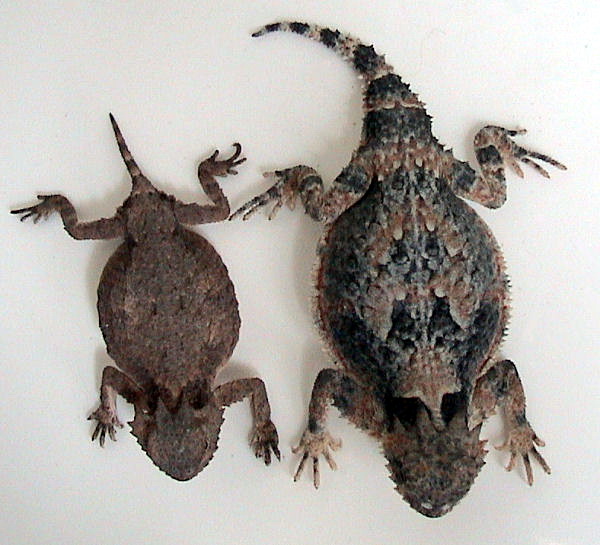Horned Lizard (Family: Phrynosomatidae, Genus: Phrynosoma) - Wiki Horned lizard
From Wikipedia, the free encyclopedia
[Photo] Comparison of Phrynosoma modestum and Phrynosoma platyrhinos. Photographer: http://en.wikipedia.org/wiki/User:Dawson Date: 7 June 2005. License: Creative Commons Attribution ShareAlike License version 2.5: http://creativecommons.org/licenses/by-sa/2.5/
Horned lizards (Phrynosoma) are a genus of the Phrynosomatidae family of lizards. The horned lizard is popularly called a "horned toad," "horny toad", or "horned frog," but it is neither a toad nor a frog. The popular names come from the lizard's rounded body and blunt snout, which give it a decidedly toad-like or frog-like appearance. (Phrynosoma literally means "toad-bodied.") The spines on the back and sides of this lizard are made from modified scales, whereas the horns on the heads are true horns (i.e. they have a bony core).
There are 14 species of horned lizards in North America, 8 of which are native to the United States. The largest-bodied and most widely distributed of the U.S. species is the Texas horned lizard (P. cornutum).
Horny lizards are morphologically similar to the Australian thorny devil (Moloch horridus), but are only distantly related. Though due to other unique similarities, such as being sit-and-wait predators and preying upon ants, these two are considered to be a great example of convergent evolution.
Horned lizards carry with them a wide variety of means to avoid predation. Their coloration generally serves as camouflage. When threatened, a horned lizard's first defense is to remain still and hope it avoids detection. If it is approached too closely and is forced to move, it generally runs in short bursts and stops abruptly, hoping to confuse the predator's visual acuity. If this fails, it will puff up its body to cause its spiny scales to protrude, making it appear larger and more difficult to swallow. At least four species also have the ability to squirt an aimed stream of blood from the corners of the eyes for a distance of up to 3 feet. The horned lizard is able to do this by restricting the blood flow leaving its head, thereby increasing blood pressure and rupturing tiny vessels around the eyelids. This not only confuses would-be predators, but the blood is also foul-tasting to canine and feline predators. It appears to have no effect against predatory birds. But the horned lizard has yet more defenses in its bag of tricks should a predator attempt to pick it up. By ducking or elevating its head and allowing its cranial horns to be oriented straight up, or back, the horned lizard can attempt to defeat a predator from taking it by the head or neck. If the predator attempts to take it by the body, the horned lizard will drive that side of its body downward into the ground so that the predator cannot easily get its lower jaw underneath the lizard.
The diet of most horned lizards species varies from 60-90% harvester ants of the genus Pogonomyrmex, though they are opportunistic and supplement these with termites, beetles, grasshoppers and other small insects. In California, Texas, and other states, horned lizards are considered threatened and given state protection, though none are on the federal endangered species list. The Texas horned lizard has declined in about 30% of its range, though there is some indication it may be making a comeback. Some California horned lizard species are also in decline. The decline is usually blamed on development/destruction of habitat, the spread of non-native South American ants which compete and war with the harvester ant, and from overuse of pesticides which kill harvester ants. In California, the introduced species is the Argentine ant. In Texas, it is both the Argentine ant and the Brazilian fire ant. Both species are highly aggressive, fiercely territorial, and prey upon harvester ant queens, destroying the horned lizard's principal source of food.
Some Native American peoples regarded horned lizards as sacred. The animal is a common motif in the art many Native Americans in the Southwestern U.S. and in Mexico.
The horned lizard is the state reptile of both Texas and Wyoming, and as the "horned frog," is the mascot of Texas Christian University (TCU).
Species
Giant Horned Lizard, Phrynosoma asio (Cope, 1864)
Short-tailed Horned Lizard, Phrynosoma braconnieri (Dum??ril, 1870)
Cedros Island Horned Lizard, Phrynosoma cerroense (Stejneger, 1893)
Texas Horned Lizard, Phrynosoma cornutum (Harlan, 1825)
Coast Horned Lizard, Phrynosoma coronatum
- Cape Horned Lizard, Phrynosoma coronatum coronatum (Blainville, 1835)
- San Diego Horned Lizard, Phrynosoma coronatum blainvillii (Gray, 1839)
- California Horned Lizard, Phrynosoma coronatum frontale (Van Denburgh, 1894)
- Central Peninsular Horned Lizard, Phrynosoma coronatum jamesi (Schmidt, 1922)
- Northern Peninsular Horned Lizard, Phrynosoma coronatum schmidti (Barbour, 1921)
Rock Horned Lizard, Phrynosoma ditmarsi (Stejneger, 1906)
Short-horned Lizard, Phrynosoma douglassii
- Phrynosoma douglassi brachycercum (Smith, 1942)
- Phrynosoma douglasii douglasii (Bell, 1828)
Mountain Short-horned Lizard, Phrynosoma hernandesi (Girard, 1858)
Flat-tail Horned Lizard, Phrynosoma mcallii (Hallowell, 1852)
Roundtail Horned Lizard, Phrynosoma modestum (Girard, 1852)
Mexican Plateau Horned Lizard, Phrynosoma orbiculare
- Phrynosoma orbiculare boucardii (Dum??ril & Bocourt, 1870)
- Phrynosoma orbiculare bradti (Horowitz, 1955)
- Phrynosoma orbiculare orbiculare (Linnaeus, 1789)
- Phrynosoma orbiculare orinetale (Horowitz, 1955)
- Phrynosoma orbiculare cortezii (Dum??ril & Bocourt, 1870)
- Phrynosoma orbiculare dugesii (Dum??ril & Bocourt, 1870)
Desert Horned Lizard, Phrynosoma platyrhinos
- Southern Desert Horned Lizard, Phrynosoma platyrhinos calidiarum (Cope, 1896)
- Northern Desert Horned Lizard, Phrynosoma platyrhinos platyrhinos (Girard, 1852)
- Sonoran Horned Lizard, Phrynosoma platyrhinos goodei (Stejneger, 1893)
Regal Horned Lizard, Phrynosoma solare (Gray, 1845)
Mexican Horned Lizard, Phrynosoma taurus (Dug??s, 1873)
Gulf Coast Horned Lizard, Phrynosoma wigginsi (Montanucci, 2004)
http://en.wikipedia.org/wiki/Horned_lizard
| The text in this page is based on the copyrighted Wikipedia article shown in above URL. It is used under the GNU Free Documentation License. You may redistribute it, verbatim or modified, providing that you comply with the terms of the GFDL. |
